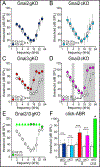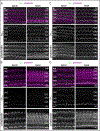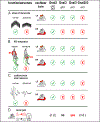Gαi Proteins are Indispensable for Hearing
- PMID: 29940568
- PMCID: PMC11825972
- DOI: 10.1159/000490867
Gαi Proteins are Indispensable for Hearing
Abstract
Background/aims: From invertebrates to mammals, Gαi proteins act together with their common binding partner Gpsm2 to govern cell polarization and planar organization in virtually any polarized cell. Recently, we demonstrated that Gαi3-deficiency in pre-hearing murine cochleae pointed to a role of Gαi3 for asymmetric migration of the kinocilium as well as the orientation and shape of the stereociliary ("hair") bundle, a requirement for the progression of mature hearing. We found that the lack of Gαi3 impairs stereociliary elongation and hair bundle shape in high-frequency cochlear regions, linked to elevated hearing thresholds for high-frequency sound. How these morphological defects translate into hearing phenotypes is not clear.
Methods: Here, we studied global and conditional Gnai3 and Gnai2 mouse mutants deficient for either one or both Gαi proteins. Comparative analyses of global versus Foxg1-driven conditional mutants that mainly delete in the inner ear and telencephalon in combination with functional tests were applied to dissect essential and redundant functions of different Gαi isoforms and to assign specific defects to outer or inner hair cells, the auditory nerve, satellite cells or central auditory neurons.
Results: Here we report that lack of Gαi3 but not of the ubiquitously expressed Gαi2 elevates hearing threshold, accompanied by impaired hair bundle elongation and shape in high-frequency cochlear regions. During the crucial reprogramming of the immature inner hair cell (IHC) synapse into a functional sensory synapse of the mature IHC deficiency for Gαi2 or Gαi3 had no impact. In contrast, double-deficiency for Gαi2 and Gαi3 isoforms results in abnormalities along the entire tonotopic axis including profound deafness associated with stereocilia defects. In these mice, postnatal IHC synapse maturation is also impaired. In addition, the analysis of conditional versus global Gαi3-deficient mice revealed that the amplitude of ABR wave IV was disproportionally elevated in comparison to ABR wave I indicating that Gαi3 is selectively involved in generation of neural gain during auditory processing.
Conclusion: We propose a so far unrecognized complexity of isoform-specific and overlapping Gαi protein functions particular during final differentiation processes.
Keywords: Cochlear hair cell maturation; Deafness gene; Gαi3/GNAI3; Heterotrimeric G-proteins; Neural gain; Stereocilia bundle.
© 2018 The Author(s). Published by S. Karger AG, Basel.
Conflict of interest statement
Disclosure Statement
The authors declare no competing financial interest.
Figures










References
-
- Neves SR, Ram PT, Iyengar R: G protein pathways. Science 2002;296:1636–1639. - PubMed
-
- Wong YH, Federman A, Pace AM, Zachary I, Evans T, Pouyssegur J, Bourne HR: Mutant a subunits of Gi2 inhibit cyclic AMP accumulation. Nature 1991;351:63–65. - PubMed
-
- Xiao RP, Avdonin P, Zhou YY, Cheng H, Akhter SA, Eschenhagen T, Lefkowitz RJ, Koch WJ, Lakatta EG: Coupling of b2-adrenoceptor to Gi proteins and its physiological relevance in murine cardiac myocytes. Circ Res 1999;84:43–52. - PubMed
-
- Pines M, Santora A, Gierschik P, Menczel J, Spiegel A: The inhibitory guanine nucleotide regulatory protein modulates agonist-stimulated cAMP production in rat osteosarcoma cells. Bone Miner 1986;1:15–26. - PubMed
MeSH terms
Substances
Grants and funding
LinkOut - more resources
Full Text Sources
Other Literature Sources
Molecular Biology Databases
Miscellaneous
